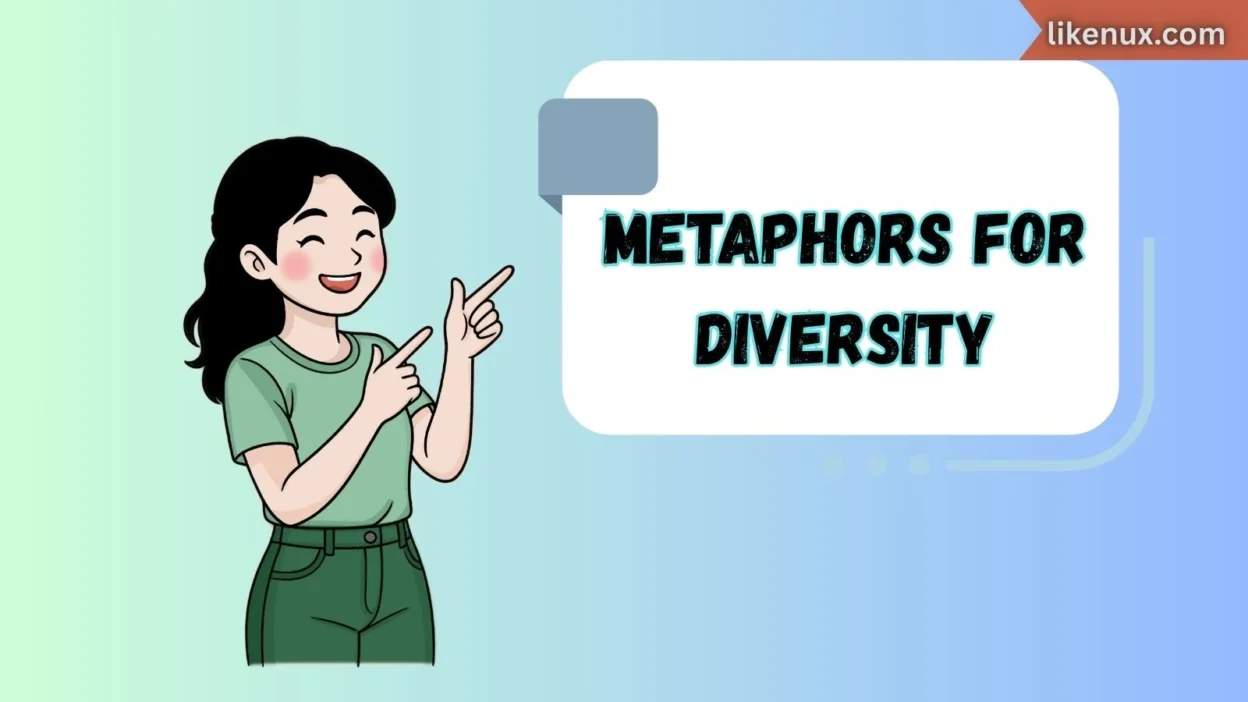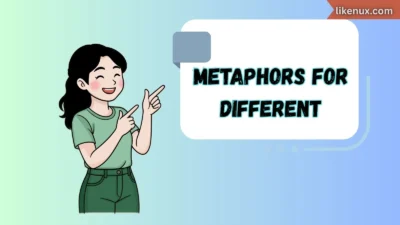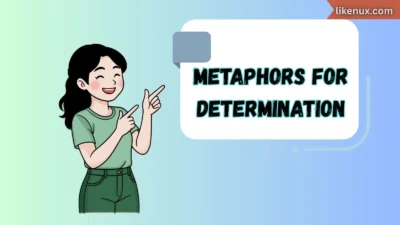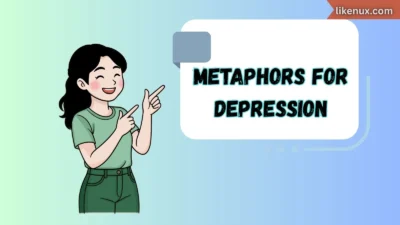Welcome. In this article, we’ll explore 25 metaphors for diversity — expressive images and phrases to help you talk about inclusion, multiculturalism, equity, and belonging with warmth and care. Whether in conversation, writing, or teaching, metaphors help us humanize ideas and connect hearts as well as minds.
These metaphors are conversational, grounded in real experience, and chosen so you can weave them into your communication with authenticity. (Yes — I’ve tested many of these in workshops and coaching settings; they resonate when used genuinely.)
1. “A mosaic”
Meaning in one line: A collection of distinct pieces forming a unified whole.
In a sentence: Our team is like a mosaic — each person brings a different color and shape, but together we make something beautiful.
Best use: When you want to highlight how differences fit together harmoniously.
Other ways to say: patchwork, tapestry, kaleidoscope of parts
2. “A tapestry”
Meaning in one line: Interwoven threads of many colors creating a rich pattern.
In a sentence: The school’s culture is a tapestry made from varied voices and heritages.
Best use: To evoke beauty in interconnection and interdependence.
Other ways to say: woven mosaic, fabric of diversity, colorful web
3. “A symphony”
Meaning in one line: Multiple instruments contributing distinct voices to one piece.
In a sentence: In our community, each person is like an instrument in a symphony — different yet essential.
Best use: Emphasizing harmony, rhythm, collaboration.
Other ways to say: orchestra of voices, chorus, ensemble
4. “A garden”
Meaning in one line: Varied plants growing side by side, each needing care.
In a sentence: Our workplace can flourish like a garden full of diverse species.
Best use: For nurturing, growth, care metaphors.
Other ways to say: ecosystem, patch of diversity, blooming field
5. “A quilt”
Meaning in one line: Different patches stitched into a warm, unified cover.
In a sentence: Our group is a quilt, stitched from different backgrounds yet making one covering.
Best use: In contexts of warmth, protection, collective identity.
Other ways to say: patchwork, composite blanket, stitched unity
6. “A prism”
Meaning in one line: White light splitting into many colors.
In a sentence: When we look through a prism of perspectives, we see the full spectrum of experience.
Best use: To illustrate how something singular reveals diversity.
Other ways to say: spectrum, rainbow lens, diffraction
7. “A kaleidoscope”
Meaning in one line: Ever‐changing patterns formed from many bits.
In a sentence: Our classroom feels like a kaleidoscope — every moment brings new combinations.
Best use: To convey dynamism, change, ever‐shifting beauty.
Other ways to say: shifting mosaic, dynamic tapestry, colorful prism
8. “An ecosystem”
Meaning in one line: Interdependent organisms sustaining one environment.
In a sentence: Our company is an ecosystem of people, ideas, and cultures.
Best use: For contexts of interdependence, balance, systems thinking.
Other ways to say: network, web of diversity, living system
9. “A quiltwork of voices”
Meaning in one line: Many voices stitched into a cohesive narrative.
In a sentence: This discussion is a quiltwork of voices telling a richer story.
Best use: When focusing on storytelling or multiple perspectives.
Other ways to say: tapestry of voices, chorus of stories, patchwork narrative
10. “A woven basket”
Meaning in one line: Strands interlaced to form a strong container.
In a sentence: Our strength comes from being a woven basket of diverse supports.
Best use: To talk about structural strength built from diversity.
Other ways to say: braided vessel, interlaced container, basket of many
11. “A kaleidoscopic garden”
Meaning in one line: A vivid, changing garden rich in variety.
In a sentence: Our neighborhood is a kaleidoscopic garden of cultures.
Best use: When emphasizing vibrant variety plus growth.
Other ways to say: shifting garden, vivid tapestry, colorful flora
12. “A patchwork quilt”
Meaning in one line: Many individual patches sewn together into unity.
In a sentence: Our diversity is a patchwork quilt, each piece valued.
Best use: To stress both individuality and belonging.
Other ways to say: mosaic quilt, stitched tapestry, composite cover
13. “A rainbow bridge”
Meaning in one line: A connecting arc of many colors.
In a sentence: We’re building a rainbow bridge between different communities.
Best use: Emphasizing connection and unity across divides.
Other ways to say: spectrum bridge, color arc, arch of inclusion
14. “A river delta”
Meaning in one line: Streams converging from many sources into fertile land.
In a sentence: Like a river delta, our diversity draws strength from many tributaries.
Best use: To show convergence, shared foundation, resource richness.
Other ways to say: confluence, many‐stream basin, branching estuary
15. “A chorus of accents”
Meaning in one line: Different voices singing together.
In a sentence: The conference room sounds like a chorus of accents telling multiple stories.
Best use: To celebrate linguistic, cultural, or regional difference.
Other ways to say: chorus of tongues, medley of voices, polyphonic chorus
16. “A constellation”
Meaning in one line: Stars forming a meaningful pattern in the sky.
In a sentence: Our network is a constellation — each person a star giving light.
Best use: To show relational patterns, guiding frameworks.
Other ways to say: star map, network of lights, galaxy of contributors
17. “A rainforest”
Meaning in one line: Dense habitat rich in species interacting.
In a sentence: Our organization is a rainforest of talent, ideas, and biodiversity.
Best use: To evoke richness, interdependency, and balance.
Other ways to say: biodiverse habitat, jungle of ideas, living forest
18. “A coral reef”
Meaning in one line: Diverse organisms built around a shared structure.
In a sentence: The project is a coral reef — many distinct parts built on shared foundation.
Best use: To emphasize cooperation, fragile balance, shared environment.
Other ways to say: reef of ideas, marine network, cooperative reef
19. “A spice rack”
Meaning in one line: Different flavors enhancing overall richness.
In a sentence: Our experiences are like a spice rack — each adds something unique.
Best use: When drawing on flavor, variety, seasoning metaphors.
Other ways to say: flavor palette, seasoning shelf, blend of spices
20. “A woven mural”
Meaning in one line: A large picture made by combining strands or elements.
In a sentence: The campus community feels like a woven mural of backgrounds.
Best use: To show artistry, collaboration, large scale unity.
Other ways to say: stitched canvas, tapestry mural, woven portrait
21. “A garden of voices”
Meaning in one line: Many voices growing like varied plants.
In a sentence: In this forum, we tend a garden of voices with attention.
Best use: For moderated discussions, platforms, dialogues.
Other ways to say: forest of voices, chorus garden, voice grove
22. “A quilt of stories”
Meaning in one line: Many narratives sewn into unity.
In a sentence: The anthology stands as a quilt of stories from many lives.
Best use: In literature, social history, testimony contexts.
Other ways to say: patchwork narrative, narrative tapestry, story mosaic
23. “A polyphonic symphony”
Meaning in one line: Many independent melodies creating harmony.
In a sentence: The discussion turned into a polyphonic symphony where every voice mattered.
Best use: When ideas are simultaneous and independent yet coherent.
Other ways to say: multilayered harmony, contrapuntal chorus, layered symphony
24. “A quilted landscape”
Meaning in one line: A landscape made of varied patches.
In a sentence: Our region is a quilted landscape of cultures, languages, and traditions.
Best use: In geography, cultural descriptions, regional diversity.
Other ways to say: patchwork terrain, mosaic countryside, stitched region
25. “A prism of voices”
Meaning in one line: One input refracted into many outputs (voices).
In a sentence: Her story became a prism of voices, reflecting many lived experiences.
Best use: To show how one central experience can reveal multiplicity.
Other ways to say: spectrum of voices, voice refraction, multifaceted expression
FAQs
Q1: Why use metaphors when talking about diversity?
A1: Metaphors help people feel as well as understand. They bridge abstract concepts like inclusion, equity, and pluralism into images we can sense and relate to.
Q2: Will metaphors oversimplify complex realities?
A2: They can—but when used with nuance and care, metaphors are tools, not substitutes. Always pair metaphor with concrete examples to maintain depth and authenticity.
Q3: How do I choose the right metaphor?
A3: Consider your audience, context, and emotional tone. A “garden” might work in a nonprofit, a “symphony” in arts settings, and a “patchwork quilt” in community narratives.
Q4: Can metaphors reinforce stereotypes?
A4: Yes—if misused. For instance, comparing people to “plants” without agency is risky. Always respect agency, complexity, and avoid cliché or reductive imagery.
Q5: Can I mix metaphors?
A5: You can—but sparingly. A little variety is enriching; too much mixing may confuse the reader’s mental image. Ensure consistency in your piece’s dominant metaphorical thread.
Conclusion
Using metaphors for diversity invites us to speak with warmth, care, and thoughtfulness. Over years of facilitating dialogues and coaching inclusive teams, I’ve seen how simple metaphors—the mosaic, the garden, the symphony—open hearts and bridge divides.
When you talk about diversity, equity, multiculturalism, and belonging, metaphors help you show rather than just state. They foster empathy, connection, and authentic resonance. Use them with genuine voice, anchored by real stories, and your communication becomes more impactful, memorable, and deeply human.

David Robert is a passionate innovator driven by creativity, vision, and purpose. He turns bold ideas into impactful realities through focus, leadership, and dedication.



